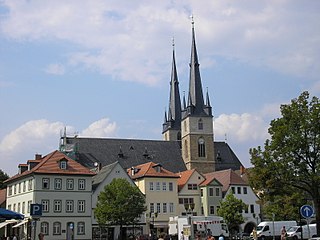Radulf or Radulph may refer to:
Henry VII may refer to:

The Carolingian dynasty was a Frankish noble family named after Charlemagne, grandson of mayor Charles Martel and descendant of the Arnulfing and Pippinid clans of the 7th century AD. The dynasty consolidated its power in the 8th century, eventually making the offices of mayor of the palace and dux et princeps Francorum hereditary, and becoming the de facto rulers of the Franks as the real powers behind the Merovingian throne. In 751 the Merovingian dynasty which had ruled the Germanic Franks was overthrown with the consent of the Papacy and the aristocracy, and Pepin the Short, son of Martel, was crowned King of the Franks. The Carolingian dynasty reached its peak in 800 with the crowning of Charlemagne as the first Emperor of the Romans in the West in over three centuries. His death in 814 began an extended period of fragmentation of the Carolingian Empire and decline that would eventually lead to the evolution of the Kingdom of France and the Holy Roman Empire.
William III or William the Third may refer to:
A count palatine, also count of the palace or palsgrave, was originally an official attached to a royal or imperial palace or household and later a nobleman of a rank above that of an ordinary count. The title originated in the late Roman Empire. In the Middle Ages especially and into modern times, it is associated with the Holy Roman Empire.
Louis II may refer to:
Hugh may refer to:
Conrad I or Konrad I may refer to:
John II may refer to:

Saalfeld is a town in Germany, capital of the Saalfeld-Rudolstadt district of Thuringia. It is best known internationally as the ancestral seat of the Saxe-Coburg and Gotha branch of the Saxon House of Wettin, which was renamed the House of Windsor during their British reign in 1917.
Frederick III may refer to:

The Margravate of Meissen was a medieval principality in the area of the modern German state of Saxony. It originally was a frontier march of the Holy Roman Empire, created out of the vast Marca Geronis in 965. Under the rule of the Wettin dynasty, the margravate finally merged with the former Duchy of Saxe-Wittenberg into the Saxon Electorate by 1423.

The Duchy of Franconia was one of the five stem duchies of East Francia and the medieval Kingdom of Germany emerging in the early 10th century. The word Franconia, first used in a Latin charter of 1053, was applied like the words Francia, France, and Franken, to a portion of the land occupied by the Franks.
Radulf was the Duke of Thuringia from 632 or 633 until his death after 642.
Thacholf, Thachulf, Thaculf, or Thakulf was the Duke of Thuringia from 849 until his death. He held the titles of comes (count) and dux (duke) and he ruled over a marca (march). He may have been the son of Hadulf, son of Thankulf.
Radulf or Ratolf was the Duke of Thuringia from 874 until his death. Radulf was the successor and possibly son of Thachulf.

The Sorb(ian) March was a frontier district on the eastern border of East Francia in the 9th through 11th centuries. It was composed of several counties bordering the Sorbs. The Sorbian march seems to have comprised the eastern part of Thuringia.
Poppo II or Boppo II was the Duke of Thuringia from 880 until his deposition in 892.
The Conradines or Conradiner were a dynasty of Franconian counts and dukes in the 8th to 11th Century, named after Duke Conrad the Elder and his son King Conrad I of Germany.
The Duchy of Thuringia was an eastern frontier march of the Merovingian kingdom of Austrasia, established about 631 by King Dagobert I after his troops had been defeated by the forces of the Slavic confederation of Samo at the Battle of Wogastisburg. It was recreated in the Carolingian Empire and its dukes were appointed by the king until it was absorbed by the Saxon dukes in 908. From about 1111/12 the territory was ruled by the Landgraves of Thuringia as Princes of the Holy Roman Empire.